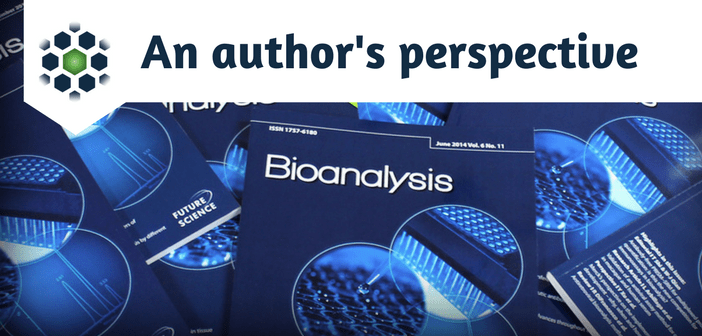An author’s perspective: Hazem Hassan on a UHPLC-MS/MS method for the quantification of doxycycline

To help provide insight into the recent article published in Bioanalysis: ‘Validated UHPLC-MS/MS method for quantification of doxycycline in abdominal aortic aneurysm’, we spoke with author Hazem Hassan, Staff Fellow, FDA and Affiliate Faculty at the University of Maryland School of Pharmacy (MD, USA). Hazem explains why he felt this was an important area for bioanalysis and worthy of publication. Hazem has been working in bioanalysis for approxiamately 12 years, focussing on this particular field of bioanalysis for 9 years.
Dr Hazem Hassan is an Affiliate Faculty at University of Maryland Baltimore School of Pharmacy (UMSOP; MD, USA). His research program was supported by grants from FDA, NIH and NIPTE and focused on investigating the underlying factors that impact drug development and drug therapy optimization in adults and pre-term neonates via employing in vitro, in vivo and in silico quantitative pharmacology approaches. He has co-authored more than 40 peer-reviewed research articles and book chapters, and has more than 90 poster/podium presentations in conference proceedings. Dr Hassan received several national and international awards including the AAPS award in Pharmacokinetics, Pharmacodynamics, and Drug Metabolism/Clinical Sciences (PPDM/CS), Dr Ralph Shangraw award, Dr Arthur Shwartz award, the Egyptian Government General Mission award and was recently selected as the ASCPT Dedicated Member. Dr Hassan is actively serving on different capacities on several scientific leadership committees including ACCP, ASCPT, AAPS and AACP (i.e., Educational, SPC, DDDI and Pharmaceutics, respectively) committees. Dr Hassan received his doctorate degree (Drug Metabolism and Pharmacokinetics), post-doctoral training (Clinical Pharmacology) and master’s degree (Pharmacometrics) from University of Maryland Baltimore (MD, USA), and received his B. Pharm from Helwan University(Helwan, Egypt). He is a registered pharmacist by NABP and a certified controlled dangerous substances researcher by the State of Maryland and the US Department of Justice.
1. What inspired you to work in this field of bioanalysis?
My research at UMSOP was geared towards the fields of Clinical Pharmacology and pre-clinical DMPK, bioanalysis goes hand-in-hand with these fields. In other words, without good, reliable bioanalytical method, one could not rely on the PK data and hence there would be little value for the highly technical PK modeling and simulation, and no sound conclusion could be made. Realizing this early on in my career, I decided to make sure that I would not embark on conducting any clinical or pre-clinical study without having a reliable validated bioanalytical method for the drug of interest.
2. What impact would you like to see/expect to see as a result of your publication?
In our most recent publication we aimed to address the need for a simple, reliable, highly sensitive bioanalytical method for quantification of doxycycline. We hope that this method will make the therapeutic drug monitoring of doxycycline more feasible, rapid and reliable.
3. What are the next steps for your research and this field of bioanalysis?
There is a strong evidence that doxycycline can benefit patients with abdominal aortic aneurysms. We collaborated with Professor Michael Terrin from University of Maryland School of Medicine (MD, USA) on an NIH funded project which aims to determine the safety and efficacy of doxycycline in preventing the growth of small abdominal aortic aneurysms. Now that we have a reliable quantification method we are on target to developing a better understanding of the role that doxycycline can play in the treatment of these patients.
4. Are there any researchers/projects/technologies that you are watching at the moment, and any you think we should be keeping an eye on?
Absolutely, there are several projects that our group at UMSOP is involved in that focus on establishing in vitro/in vivo correlations for transdermal products. These projects involve conducting a series of clinical and in vitro permeation studies. As mentioned earlier, we only embark on conducting studies when we have a solid and reliable bioanalytical method. These studies were no different and in fact, our recently developed bioanalytical method for quantification of fentanyl was published in Bioanalysis in 2017 and was paramount in conducting our fentanyl clinical studies.
5. Do you have any advice for anyone who may be interested in working in this field?
My advice for those who are interested is simple; read, study and understand the FDA Guidance for Industry for Bioanalytical Method Validation. It is a great resource – it would definitely help you to grow and establish your own successful career in this field!
Reference: LINK TO FOLLOW ONCE ARTICLE LIVE
